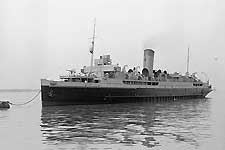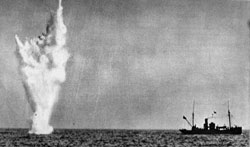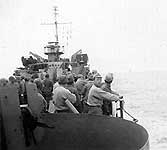| By 1946, and after spending six and a half years in the RN, Frank Mathews Lieutenant (E) |
|
| RNVR, had experienced many key events in the conflict sea |
|
 |
 |
|
 |
| Dunkirk veteran HMS St Tudno |
|
M/S Trawler destroys a mine at a safe distance |
When the war was declared in September 1939, I was an apprentice engineer, with night school studies in order to gain my qualifications in this field. It was hard work, and I was anxious to participate for my country before the war ended, I think we were all so confident that it would be over in six months. This prompted me to volunteer for the Royal Navy at their recruiting office in Leeds for the Engineering Branch. I sat their engineering examinations plus the medical, and was excepted as a Petty Officer Articifer, joining Chatham Barracks on the 6th May 1940.
There was a very brief spell of induction training, because of a sudden draft to Sheerness to join H.M.S. St Tudno, a converted ferry, and after boarding the ship was on its way, I had no information as to where, it turned out to be to Dunkirk for the evacuation of the British Expeditionary Force. There I had my first experience of dive bomb attack during the several trips to and fro' from France.
June 1940 I was transferred to minesweepers to combat the magnetic, and later the acoustic mines which the Germans were dropping into the shipping lanes of the North Sea. I joined the first minesweeper, a converted trawler, at Grimsby. My duties were the maintenance and operation of the special LL and acoustic sweeping equipment installed on the trawlers, which were crewed mainly by ex-fishermen and as such I went out on varying ships over the two year period, but I recall HMTs War Duke, Remexco, Reconc, Meror and many 'Town named trawlers, and then onto specially wood built MM's and American built BYMS's which were numbered and not named. The sweeping operation involved two sweepers sailing abreast towing two buoyant cables astern, pulsing out electric current, the ships being degaused so as not to trigger the mines, which lay on the sea bottom, as the ship passed over them. Unfortunately this did not always work, and I survived the loss of five sweepers, being hospitalized twice. As a result of one experience I receive a War Disability Pension. The shipping lanes we had to keep open from Grimsby were north to Flamborough and south of Sheringham.
I left Grimsby in August 1942 to take part in North Africa invasion on November 1942, followed up the Mediterranean operations at Sicily, Malta, Anzio, Corsica, Madalena by Sardina.
By this time I had received a Royal Commission, and from March 1943 to August 1946 I was the Engineer Officer of H.M.L.S.T. 321. These ships were called ships with bow doors designed for the speedy discharge of tanks, vehicles and equipment direct onto the beaches. As well as the Mediterranean operations the ship took part in the Normandy landings on the 6th June 1944 with follow up trips with equipment through Belgium and Holland. After Germany surrendered the ship was re-equiped for Far East operations, taking part in Operation Zipper for landing on Malaya. This was due when the atom bombs were dropped on Hiroshima and Nagasaki in Japan. Next we sailed down to Singapore and took the surrender of the Japanese garrison. The ship then sailed to Borneo taking the Japanese prisoners from the northern towns and ports back to Labuan Island, some for war atrocity trials. While accepting the surrender of a Japanese settlement in North Borneo, I received the Samurai sword and a pistol from the Japanese major commander of the settlement near Sandaken.
 |
 |
|
 |
|
| [Far left] - Japanese prisoners returning home on a LST (Landing Ship Tank) |
 |
| Hiroshima- ' .. the atom bomb damage, which was devastating, hopefully never to be repeated.' |
|
I brought the sword and pistol home after the war with a certificate stating they were war souvenirs but recently gave the pistol to the police during the amnesty. The police considered the pistol to be so unique that they contacted Leeds Armoury and the gun is on display at the Armoury with a description on how I obtained it.
From Borneo we sailed to Brisbane, Australia to embark and transport an Australian Air Force occupation force to the port Kure, Japan where they were to occupy an air-field at Iwa-Kuni about nine miles from Hiroshima. I was invited by them to travel to Hiroshima to view the atom bomb damage, which was devastating, hopefully never to be repeated.
My ship H.M.L.S.T. 321 was American built and under the terms of the Lease-lend agreement, had to be returned to Kubic Bay, an American Naval Port in the Philippine Islands, where I was decommissioned the ship and returned home on passage in August 1946 to civilian life with the rank of Lieutenant (E) R.N.V.R.
 |
 |
|
| Because my activities took me into every war theatre, it qualified me for every campaign medal issued with relevant clasps. For my ship's involvement in the Normandy Landings, I was awarded the "Medaille Du Jubule" and Certificate from Reno Garrec, Le President du Conseil Regional de Basse-Normandie at the Jubilee celebrations of the landings. |
 |
| Medaille Du Jubule |
|
Frank Matthews 2000 |